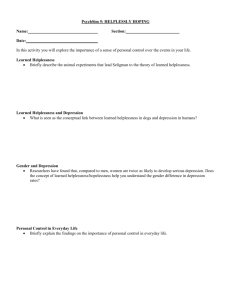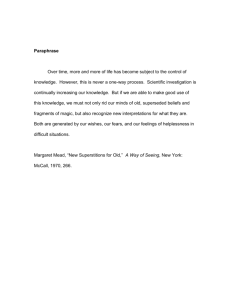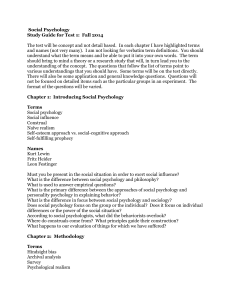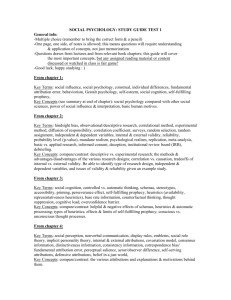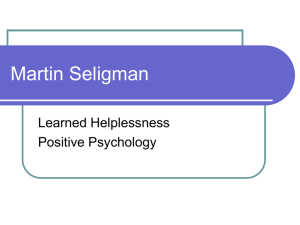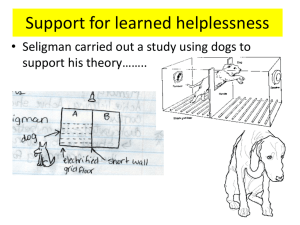Learned helplessness within the context of social interaction
advertisement
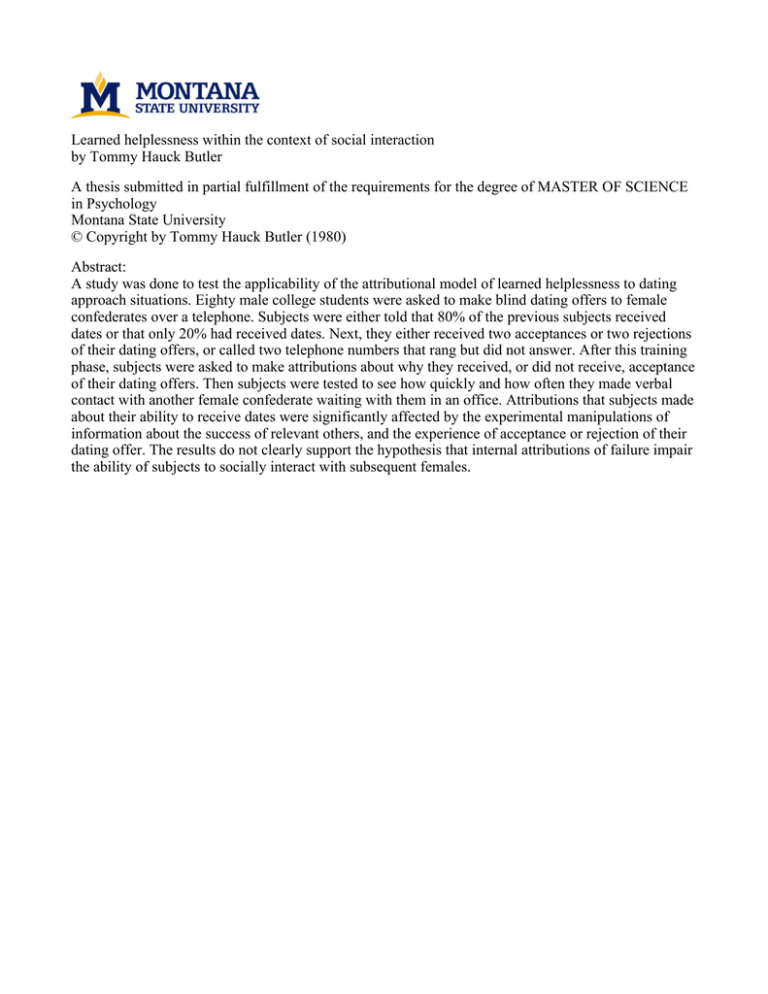
Learned helplessness within the context of social interaction by Tommy Hauck Butler A thesis submitted in partial fulfillment of the requirements for the degree of MASTER OF SCIENCE in Psychology Montana State University © Copyright by Tommy Hauck Butler (1980) Abstract: A study was done to test the applicability of the attributional model of learned helplessness to dating approach situations. Eighty male college students were asked to make blind dating offers to female confederates over a telephone. Subjects were either told that 80% of the previous subjects received dates or that only 20% had received dates. Next, they either received two acceptances or two rejections of their dating offers, or called two telephone numbers that rang but did not answer. After this training phase, subjects were asked to make attributions about why they received, or did not receive, acceptance of their dating offers. Then subjects were tested to see how quickly and how often they made verbal contact with another female confederate waiting with them in an office. Attributions that subjects made about their ability to receive dates were significantly affected by the experimental manipulations of information about the success of relevant others, and the experience of acceptance or rejection of their dating offer. The results do not clearly support the hypothesis that internal attributions of failure impair the ability of subjects to socially interact with subsequent females. STATEMENT OF PERMISSION TO COPY In presenting this thesis in partial fulfillment of the require­ ments for an advanced degree at Montana State University, I agree that the library shall make it freely available for inspection. I further agree that permission for extensive copying of this thesis for scholarly purposes may be granted by my major professor, or, in his absence, by ■ the Director of the Libraries. It is.understood that any copying or publication of this thesis for financial gain shall not be allowed with­ out my written permission. Signature Date ^ q__________ JJ?_____ ' 13 .flffi LEARNED HELPLESSNESS WITHIN THE CONTEXT OF SOCIAL INTERACTION .by TOMMY HAUCK BUTLER A thesis.submitted in partial fulfillment of the requirements for the degree of MASTER OF SCIENCE ■' in Psychology Approved: Chairman, Graduate Committee MONTANA STATE UNIVERSITY . Bozeman, Montana .August, 1980 • .".-S ii'i ACKNOWLEDGMENTS My thanks•and deep appreciation are due my academic mentor, Dr. Douglas Kenrick, for his ceaseless guidance-, encouragement, and good humor. Thanks are also due my confederates: Debbie, Willa, Kathy, and Connie, whose cheerful attitudes and helpful suggestions made the long hours of experimentation pass quickly. TABLE OF CONTENTS Page V I T A ............................................. .. ii ACKNOWLEDGMENTS . ............. iii LIST. OF T A B L E S .......... .. . ................... ABSTRACT v . . ...........'................... INTRODUCTION ............ '.................... Previous Research in Learned vi I Helplessness . . . . . . . I The helplessness p a r a d i g m ........ .. .............. Causal factors of learned helplessness . . . . . . . . The attributional theory of helplessness ......... Hypothesis .......... ................. . . . 3 4 5 METHOD . ; . . .............. . . . . . . . . . . . . . Subje c t s ........ .. . . ................. Procedure . . . . .................. Dependent Measures . . .............: ................ R E S U L T S .......... ............................ ' ........ . Interactions with Confederates.............. .. . . . Attributional Measures . . ............ Prior Expectations . . . . . . . . . . . . . . . . . . D I S C U S S I O N ................................... LITERATURE CITED APPENDIX 9 9 10 12 13 13 13 15 16 ........ '................... ^ .................... 8 . . . . . . . . . . . . 22 26 V LIST OF TABLES TABLE I. Page Mean Amounts of Responding to the Subsequent Female After the Training P h a s e .......................... 14 vi ABSTRACT A study was done to test the applicability of the attributional model of learned helplessness to dating approach situations. Eighty male college students were asked to make blind dating offers to female confederates over a telephone. Subjects were either told that 80% of the previous subjects received dates or that only 20% had received dates Next, they either received two acceptances or two rejections of their dating offers, or called two telephone numbers that rang but did not answer. After this training phase, subjects were asked to make attri-■ buttons about why they received, or did not receive, acceptance of their dating offer's. Then subjects were tested to see how quickly and how often they made verbal contact with another female confederate waiting with them in an office. .Attributions that subjects made about their ability to receive dates were significantly affected by the experimental manipulations of information about the success of relevant others, and the experience of acceptance or rejection of their dating offer. The results do not clearly support the hypothesis that internal attributions of failure impair the ability of subjects to socially interact with sub­ sequent females. Lr INTRODUCTION Previous .Research in Learned-Helplessness Within the past ten years, much attention has been given to the phenomenon of learned helplessness, an impairment of instrumental re­ sponding and learning resulting from overexposure to uncontrollable aversive stimuli. The phenomenon was first discovered in escape-avoid­ ance conditioning studies with dogs by Seligman and Maier (1967) and Overmier and Seligman (1967). They reported that dogs exposed to ines­ capable shock in a training phase subsequently showed a decrease in the. number of responses to cope with solving an escape problem. were tested in a shuttle box in both experiments. By jumping tral barrier, the dogs could escape an electric shock. The dogs the cen­ Upon being placed in the shuttle apparatus, dogs subjected to prior inescapable shock ran in circles, whined, barked, and eventually laid down passively upon the floor of the apparatus and made no further attempts to escape, even though they were being shocked at the time. Seligman coined the term "learned helplessness" from the appearances that the dogs had given up all attempts to respond to the noxious stimulus. Subsequent studies focused upon the alleviation of the induced behavioral deficits (Seligman, Maier, and Geer, 1968) and the occurrence of the phenomenon in species such as cats (Thomas and Balter, in press), rats (Brand, Wepman, and Russo, 1969; Maier, Seligmah and Soloman, 1969; and Maier and Testa, 1975) and fish (Padilla, Padilla, Ketterer and Giacolone, 1970). Much of the current interest in the fields of learned 2 helplessness is focused upon the documentation of the phenomenon in humans. Thus, much of the early animal research in helplessness is now being scrutinized for its applications to human behavior. Many studies have successfully induced the behavioral deficits that typify the be­ havior of helpless organisms by using experimental manipulations (aver­ sive tones, simple cognitive tasks, escape-avoidance techniques) that ■ are similar to those used in the early animal work (Hirota, 1974; Hiroto and Seligman, 1975; a n d ’Klein and Seligman, 1976). ' The purpose of this study was to determine whether learned help­ lessness could be induced within the context of social interaction; that is, whether young men decrease their approach responses to females after having been rejected previously by other females. Furthermore, evidence was gathered that determined whether .the resulting behavior and attri­ butions of such rejected people parallels the behavior and attributions of people afflicted with learned helplessness. Obviously, when one extends the helplessness paradigm to human subjects, one is not limited by strictly observational data. ask the subject to attribute causality to outcomes. One may Humans do not look merely at basic outcomes; they look at cause-effect relationships; they infer; they deduce. For example, often, one is confronted with informa­ tion that one has been unsuccessful in obtaining a desired outcome. certain situations this may lead.ah individual to conclude that he.is indeed helpless to do so generally, while in other cases the outcome In 3 ■may be attributed to factors of luck, unusual, task difficulty, and so on. In this experiment, we hope to see whether information about the outcomes of relevant others results in altered attributions for our subjects about their own 'outcomes. And in turn, we hope to determirie whether subjects who make particular attributions are more likely to lapse into helplessness than are others. By varying the information supplies to a subject, it may be determined that a.subject's judgment of why a woman.rejected his dating offer is more important than just the fact that his offer was rejected. The helplessness paradigm. to learned.helplessness research. One experimental paradigm is central As Miller and Norman '(1979, p. 94) explain: In the typical study, subjects receive a training phase followed by a test phase. In the training phase, subjects are exposed to a training task in which they receive either; a) contingent (response dependent) reinforcement; b) non-contingent.(response independent) reinforcement; or c) no treatment (control). After this training phase, the performance of the three is compared- on a test task, in which reinforcement is contingent for all groups. Learned helpless­ ness occurs when the subjects receiving non-contingent reinforce­ ment in the training phase show deficits in the test phase relative to contingent and control groups'. Thus learned helplessness refers to behavioral deficits produced by' exposure to non-contingent out­ comes . Seligman (1975) proposed that learned helplessness: I) "Inter­ feres with learning that responding controls the outcome; 2) reduces the motivation to control the outcome; and 3) produces fear for as long as the subject is uncertain of the uncontrolability of the outcomes. 4 and then produces depression.11 These correspond to the cognitive, motivational, and affective deficits respectively. v' Causal factors of learned helplessness. - According to Seligman1s theory (1973, 1974, 1975) the dominant causal factor in the development of learned helplessness is the organism's belief or expectancy that its responses will not influence the future probability of environmental outcomes. Seligman also.postulates three factors that may limit the' expectation of response-outcome independence. outcome expectancies. I)- Previous response- That is, if subjects have been strongly condi­ tioned to associate specific responses with specific outcomes, it will be more difficult to induce learned helplessness by showing the subject . that no response elicits the desired outcome. inate between situations. 2) Subjects may discrim­ If subjects do not generalize their experi­ ence from the training task to'the testing task, no helplessness will be found. The training and testing tasks must possess a minimum amount of similarity,. tant. 3) Subjects may not consider the situation to be impor­ The greater the subject's perceived importance of the training tasks, the more likely it is that helplessness will be observed. Variables'that have been found to affect the development of learned helplessness include amount of exposure to the uncontrollable stimulus (Roth and Kubal, 1975), instructional set (Glass and Singer, 1972; Hiroto, 1974), task importance (Roth and Kubal, 1973; Klein et al, 1976; Tennen and Eller, 1977), and the subject's perceived locus of • 5 control (Rest et al, 1973). '' The attributions! theory of helplessness. In line with Selig- man’s notion that helplessness results mainly from causal expectancies of response-outcome independence, an attributions! framework has been used as a guide for the study of learned helplessness in this paper. A specific attribution theory of helplessness has been,proposed by Miller and Norman (1979). They assert that the necessary conditions for learned helplessness to occur are: a) an appropriate attribution of causality that leads to-an expectation of response-outcome independence, and b) an expectation of failure. Miller and Norman further refine the etiology of learned helplessness by building on Weiner's (1974) work on attribution theory. Weiner postulates that attributions can be charac­ terized by two dimensions: locus of control (internal vs. external) and stability (stable vs. unstable). Miller and Norman also hypothesize that the subject evaluates various aspects of the environment for infor­ mation. This- environmental information consists of outcome cues and situational cues. _ Outcome cues are defined as "the characteristics of the feed­ back concerning an individual's performance in a certain situation" (Miller and Norman, 107). This would consist of responses made and the resultant outcomes as well as the desirability of that outcome. "Situa­ tional cues- refer to stimuli present in the situation itself that in- " fluences the individual's perception and the interpretation of outcomes" 6 (Miller and Norman, p . 107). They include: I) instructions regarding the contingency of responses and outcomes (Glass and Singer, 1972; ■>: Hiroto, 1974); 2) instructions regarding task difficulty (Klein et al, 1976); and 3) instructions and other task cues specifying the nature of the tasks (Roth and Kubal, 1975). Other situational cues that are hypothesized by attribution theory to influence the development of attri­ butions include social norms, observation of another's performance, and type of task (Weiner, 1975). Thus, individual differences in- subjects, outcome cues, and situational cues interact to influence the formation of a particular attribution. In the present study, situational.and outcome cues will be man­ ipulated to induce internal or external attributions. The task is the solicitation of a blind date over a telephone. -The .male subjects will be told either.that. 20% of the previous subjects received acceptances or that 80% of the previous subjects received acceptances. This infor­ mation about the success of relevant others is thus a situational cue. Subsequently, subjects will either experience acceptance or rejection of their dating offer. outcome cue. This manipulation can be considered to be an It is hoped by manipulating these, internal and external attributions can be- induced. Both these manipulations are intended to highlight the behavioral differences between personal and universal helplessness. 7 Abramson et al (1978) notes that there are different.types, of helplessness according to the attributions that subjects utilize: Situations in which subjects believe they cannot solve solvable problems are instances of personal helplessness. Alternatively, situations in which subjects believe-that neither they nor relevant others can solve the problem are' instances of universal helpless­ ness . . personal helplessness entails a low efficacy expecta■ tion coupled with a high outcome expectation (the response producing the outcome is unavailable to the person), whereas, universal help­ lessness entails a low outcome expectation (no response produces the outcome). . . This implies that-one's helplessness can be due to internal or external factors. Universally helpless subjects should make attributions of causality to external factors, while personally helpless subjects should make internal attributions.. Hence, it is predicted that, in the present research, male subjects who are,rejected and told that only 20% of the previous subjects received dates would most likely blame the female or the situation for their- failure. shouldn't show affective deficits. Also, it is predicted that they By contrast, it is thought that subjects who are rejected, yet are told that 80% of the previous sub-■ j'ects received dates, would most likely blame themselves for their failure. As a consequence, these personally helpless subjects will be thought to experience more affective deficits than the universally helpless subjects. Obviously, subjects possess some prior expectations about any task. Attribution theory indicates that when learned helplessness out­ comes are different from previously held expectancies, attributions 8 tend to be made to external, variable, and specific.causes. Conversely, if learned helplessness outcomes are congruent with previously held expectancies, attributions tend to lend to internal, stable, and general causes (Feather, 1969; Feather and Simon, 1971; Gilmore and Minton, 1974). In this experiment, subjects were asked their prior expecta­ tions before participating in the training phase. Hypothesis. It is hypothesized that college males who have previously experienced acceptances to their dating offers by females will make more approach.responses toward a subsequent female than will college males who experienced rejection of their dating offers. Follow­ ing the reasoning of the attribution model of helplessness by Millerand Norman (1979), it is also hypothesized that subjects who are given situational cues which lead them to make attributions of causality about their failure to internal causes will respond less quickly, and less often than will males who experienced failure to receive accept­ ances and were led to make attributions that were external. 9 METHOD The experiment was 2 (acceptance information: 3 (outcome: high vs. low) x acceptance, rejection, and control) factorial design. De­ pendent measures taken were the subject's attributions of causality (attributions to self, attributions to others), latency and amount of verbal contact. •■ Subjects The subjects used in the study were 80 male college students enrolled in introductory psychology courses. The subjects received class credit for their participation in the experiment. The subjects were instructed that participation in the experiment was strictly volun­ tary and they would receive full credit even if they declined to parti­ cipate in the experiment at any time. the experiment. Eight subjects were dropped from They either guessed or heard the true purposes of the experiment,' or were familiar with the female confederate leaving a total of 72 for data analysis (12; per cell). Procedure The training situation was' conducted by a male experimenter. Male subjects arrived singly and were instructed that "the experiment that we will be conducting is concerned with the reactions of female ' ; I subjects.to various types of invitations for a date." The subject was . asked if he was willing to "participate as a confederate in running this 10 experiment". Next, he was given a sheet which asked: "Generally, how successful are you with members of the opposite sex?" He was asked to respond on a scale from I) "not at all" to 9) "very much". This con­ stituted a measure.of the subject's prior expectation of success. Then the subject was instructed to examine a bogus list of prospective female ".subjects", and was told that: The female subjects believe that they are participating in a computer-dating experiment. They are introductory psychology students like yourself, although they are not from your section. We have instructed them that they should remain home during certain hours; that they should expect a telephone call about a dating offer. We told them that they were free to accept or reject any dating offer they receive. They truly believe that "they are participating in a computer-dating study. Next, the subject was asked to select two names from the bogus list to telephone and ask for a date. The experimenter gave the male subject the telephone numbers of two female confederates, and then told the sub­ ject that either 20% or 80% of the previous subjects received accept­ ances. (In the control condition, subjects were told the same instruc­ tions as the subjects in the acceptance.and rejection conditions, but were given telephone numbers that rang but did not answer. The experi- f,, ,, menter explained that "these subjects were told- to be home during these hours, otherwise they won't receive credit for participating'.'.) In the 1.1 acceptance and rejection conditions, two female confederates were in­ structed to speak with the subject in a standard manner, and to accept or reject the offer, of his date. Subjects were either given two accept­ ances or two rejections. The male subject was next asked to complete a questionnaire de­ signed to elicit his attributions of causality for success or.failure ■ in the training task (see Appendix A). Then, the subject was asked to wait for "another experiment in which you will be tested on a tachistoscope". He was brought to wait in another room in which a female con­ federate was sitting ■"while the testing machinery was being readied". The confederate was "blind" as to the experimental condition of the subjects. She was instructed to be indifferent toward the subject for the first five minutes; to answer any questions or comments tersely with one sentence; and not to stimulate conversation. three dependent measures were taken: As indicated above, I) the length of time it took for the subject to begin talking to the confederate; 2) the total amount of time within the first five minutes that the subject talked to the con­ federate; and 3) the number of separate verbal responses,that the sub­ ject made to the confederate during the first five minutes.• After the initial five minute period, the confederate was instructed to initiate verbal contact with the subject, and show interest in him in order to remove any negative effect that may have been induced during the train-' ing phase. The subject was then fully debriefed by the experimenter, 12.. and the purpose of the experiment were explained to him. Dependent Measures The attributional measures were derived from a questionnaire given.to the subjects after the training phase. The questionnaire asked the subject to assign a cause to the outcome of their first and second telephone call. Attributions to self (AS) is a self-rating on a.scale from I) "not at all" to 9) "very much", in response to the question: "Was this outcome due to something about'you?" This rating was designed to tap whether the subject was making an internal or external attribu­ tion; i.e., whether he felt responsible for the. outcome or not. Attri­ butions.toeother (AO)„-_is:. also: a„..self-rating .on a;.similar scale, in re-^ sponse to the question: female subject?" "Was the outcome due to something about the This indicated how much subjects thought the tele­ phone confederates were responsible for the outcome. All of the other dependent measures represent the timed behavior, of the subject in the testing phase. These were: I) latency to initiate conversation, 2) number of conversations initiated, and 3) the amount of time spent talk­ ing. 13 RESULTS Interactions with Confederates A two-way, fixed constants (subject replicated) analysis of variance was performed upon all dependent measures. No effects were found to be significant for latency of time to begin talking to the con­ federate , the number of responses that the subjects made to the confed­ erate, or the amount of time spent talking with the confederate. F values <2.35, all P values >.132) (All Results are displayed in Table I. Attributional Measures' No significant effects were found for attributions about others (AO). (All F values <1.95, all P values >.168) were found for attributions to self. Significant effects Main effects were found for infor­ mation about the previous success of relevant peers, (mean scores were 6.37 for the high information group and 4.91 for. the low information group) F (1,71) = 170.95, P <..001; and for outcome (mean scores were 6.25 for the accepted group and 5.04 for the rejected group) F(l,71) = 9.75, P = .0027. These results must be interpreted in light of a signi­ ficant two-way interaction, as shown in Table I. F (2,71) = 4.28, P = .018, which suggests that both main effects were due to the fact that rejected subjects who were given low information were less likely to attribute the outcome to themselves. 14 Table I Mean Amounts of Responding to .the Subsequent Female After the Training Phase Infor­ mation HIGH Group Latency to Respond 'Amount Talking Number of Responses CONTROL 6.751 (5.52) 35.5 (50.39) 2.58 (2.67) ACCEPTANCE AO* — —— ' 4.25 . (3.98) 6.50 (1.24) 6.58 (1.50) 2.33 (3.14) 6.25 6.08 (71.03) (1 .35 ) ' (1.37) 6.58 (8.09) 36.25 (58.00) 2.33 (2.77). ’— ACCEPTANCE 12.50 (16.99) 41.00 (67.00) 3.41 (2.90) 6.00 (0.95) ■ 5.91 (1.67) 10.16 (10.37) 24.83 (36.67) (2 .93) 3.83 (2.16) 5.33 (2.30) REJECTION CONTROL 'LOW AS* REJECTION 6.75 • (6.04) (27 .67 ) 40.66 9.33 (14.33) 28.25 2.33 . — *AS = attributions to self, AO ='attributions to others. ^All times listed in seconds, standard deviations of mean listed in parentheses. ' 15 Prior Expectations Prior expectation ratings in all groups were split at the median to create a new independent variable (high expectation•- low expecta­ tion) . However, no significant, main or interaction effects were found for this variable with any of the dependent measures. DISCUSSION • Although the results of this study were generally in the pre­ dicted direction, no significant results were obtained that would clearly support the hypothesis that internal attributions of failure . impair the ability of male subjects to socially interact with subse­ quent females. However, results do indicate that information about the responseoutcome contingency and information about the performance of relevant others did interact to influence the attributions that subjects made. The results of the attribution manipulation checks largely agreed with our predictions. Subjects presented with an,experience of rejection and high information about the success of relevant others, made more internal attributions about why they, did not receive acceptances to their dating offers, compared with subjects in the "rejection-low in­ formation" group. Subjects in both success-conditions, made relatively ■ internal attributions. These findings are in agreement with the ,find­ ings of Klein et al (1976) and Tennen and Eller (1977)-. Both studies , manipulated response-outcome contingencies to induce varying attribu­ tions in their subjects. Even though no significant differences between experimental groups were exhibited, one cannot automatically accept the null hypo­ thesis; several other possibilities remain as viable explanations for the results. 17 Cook, Cruder, Hennigan and Flay (1979, p . 608) list several criteria for a valid acceptance of a null hypothesis: a) When the theoretical conditions necessary for the effect to occur have been explicated, operationalized, and demonstrably met in the r e s e a r c h b ) when all the known plausible countervailing forces have been explicated, operationalized, and demonstrably met in the research ; c) when.statistical analysis iS'powerful enough to detect at least the theoretical expected maximum effect at a pre­ ordained alpha level; and d) when the manipulations and measures are demonstrably valid. Theoretical conditions for the induction of learned helpless­ ness in this study appear to have been met. Subjects were given pro­ longed exposure to learned helplessness outcomes. Subjects in the "re- ' jection" groups found that any response that they emitted was independent of the desired outcome, and all of their attempts to control the outcome resulted in failure. Also, debriefing indicated that subjects were in­ fluenced strongly by the outcome manipulations. ' Miller and Norman hypothesized that a subject's attributions of causality for a situation may have an effect upon subsequent expecta­ tions of personal control over similar situations. It was predicted that internal attributions of failure result in learned helplessness. This was operationalized by informing subjects that either 80% or only 20% of the previous subjects had received dates. This measure was thought to induce either internal or external attributions in the vari­ ous groups. Manipulation checks on the attributions of the various ex­ perimental groups largely agree with the predictions made. 18 Several countervailing forces may have existed, however. One possibility is that the testing task (talking to a female confederate) was not important for many of the subjects. Even though they made in­ ternal attributions of failure or success, they might not have been motivated to interact with a female "on their own". From the predic­ tions of Miller and Norman (1979) and the results of Roth and Kubal (1974) one may assume that the subjective importance of the training and testing tasks directly affects the intensity of the learned help-' lessness. However, it is■not known how important the training and test­ ing tasks were for the various subjects. During debriefings with the subjects, several of them noted that they were married and they thought that it affected how they reacted to the female confederate waiting in the office (the testing phase); i.e. they did not normally make approaches to unknown females. Although data was not gathered on the current dat­ ing behavior of the subjects, it is probable that many of the subjects tested were either married or involved in other steady heterosexual re­ lationships. Thus it appears possible that the' dependent measure of interacting with a subsequent female may not have been valid for sub­ jects who were not predisposed to make any response to the unknown, female confederate. In future studies, it would be useful to record the current dating behavior of each subject. Another possibility of a countervailing force is that subjects may not have generalized their experience of failure or success with the 19 ' telephone confederates to their meeting with the female confederate waiting in the office. This may have been due to two factors: I) sub­ jects may have been able to discriminate between the training and test­ ing tasks. Seligman (1973,.1974, 1975) has postulated that discrimina­ tion between the training and testing tasks may nullify the effects of an expectation of response-outcome independence. In this experiment, it may be possible that the subjects.did not perceive the solicitation of a blind date and sitting in an office with a female to be very simi­ lar tasks. If this discrimination between the two situations occurred, then no helplessness would be observed. 2) Subjects may have made spe­ cific attributions of causality about the outcome of the training task that prevented any behavioral deficits in the testing phase. Both the training and testing phases involved conversational interaction with a female. However, in the training phase, instructions given by the experimenter limited how the subjects could respond to the confederate on the telephone. No such limitations existed for the testing phase. . The rigid instructional set and other manipulations in the training phase may have induced specific attributions of causality about the out­ comes of the training phase. .For example: a general attribution by a subject in the."reject-high information" group might be "I always do worse than other guys when I try to get a.date". A specific attribu- tion for that same subject might be "I didn't do as well as the other guys because I usually get to know girls before I ask them out". - 20 Depending upon the specificity of their attribution, subjects may not ihave been induced to generalize the results of the training phase (acceptance or rejection) to their ability to interact with the female ■ confederate waiting in the office. Miller and Norman state: The specificity of the attribution is postulated to predict the number of future tasks.that will be affected by the expectancies developed in the training phase. For example: if a subject attri­ buted learned helplessness outcomes to his ability to solve dis­ crimination problems, a specific cause,then expectancies for and performance on future math problems should not be affected. But if the attributions were to a general cause, ability to-solve prob• Iems, then expectancies.for and performance on future math problems should be affected. Thus . . . attribution of learned helplessness outcomes to a general cause will tend to increase the influence of the training phase outcomes on, expectancies and performance in dif­ ferent types of tasks (1979, p. HO) . It is also possible that the dependent variables chosen were not valid. It may be that one would find that subjects with lowered self-efficacy expectations for social interaction.would choose not to interact with others simply by removing themselves from situations where they might be induced to interact. In this- experiment, the experimenter instructed the subject to wait in .the office until the experimenter re­ turned. Possibly, not to talk in such a situation would be considered rude by many of the subjects. Thus, talking to the female confederate may not have been a measure of dating approach tendencies. In future studies of this type, it would be useful to ascertain whether the de­ pendent measures are reliable indicants of attraction or approach.re­ sponses; perhaps through elaborate pre-testing. 21 It is also possible that the dependent variables chosen were not sensitive enough to the effects that were sought. Even though the dependent measures taken indicated that the effects were in the pre­ dicted directions, a great range was found in the data, for all dating approach measures. , In summary, .the findings of this study are in agreement with the predictions made from attribution theory (Weiner, 1974) that infor­ mation about how relevant others perform, and direct information about the response-outcome contingency will interact in influencing one's attributions. Attribution theory also predicts' that attributions should influence both one's expectations and one's performance of future tasks. Although no significant differences between experimental groups were found, the conditions for accepting the null hypothesis were not met in this study. As indicated'above, two criteria for acceptance of the null hypothesis may not have been met: I) not all know plausible, counter­ vailing forces had been explicated, operationalized, and demonstrablyvalid. Thus it is concluded that this study cannot in itself rule out the possibility that internal attributions of failure result in increased susceptibility to learned helplessness. LITERATURE CITED 23 Abramson, L . -Y., M. E. P . Seligman and J. D. Teasdale. Learned Help­ lessness in Humans: Critique and Reformulation. Journal of Ab­ normal Psychology, 1978, 87, 49-74. Braud, W., B. Wepman and D . Russo. Task and Species Generality of the "Helplessness" Phenomenon. Psychonomic Science, 1969, 16, 154-155. Cook, T . D., C . L . Cruder, K. M. Hennigan and B. R . Flay. History of the Sleeper Effect: Some Logical.Pitfalls in.Accepting the Null Hypothesis. Psychological Bulletin, 1979, 86, No. 4, 662-679. Dweck-, C. S . and N. D. Repucci. Learned Helplessness and Reinforcement Responsibility, in Children. Journal of Personality and Social Psychology, 1973, 25, 109-116. Feather, N. T. Attribution of Responsibility and Valence of Success and .Failure in Relation to Initial Confidence and Task Performance., Journal of Personality and Social Psychology, 1969, 13, 129-144. ■ j Feather, N. T. and J . G. Simon. Attribution of Responsibility and Val­ ence of Outcome in Relation to Initial Confidence and Success and Failure of Self and Other. Journal of Personality and Social Psy­ chology, 1971, 18, 173-188(a). Fosco,'E. and J . Geer. Effects of Gaining Control- Over Aversive.-Stimuli After Differing Amounts of No. Control. Psychological Reports, 1971 29, 1153-1154. Gatchel, R. J., P . B . Paulus, and C . W. Maples. Learned Helplessness and Self-Reported Affect. Journal of Abnormal Psychology, .1975, 84, 732-734. Gatchel, R. J., and J . D. Proctor. -Psychological Correlates of Learned Helplessness in Man. Journal of Abnormal Psychology, 1976, 85, 27-34. G e e r , J., G. C. Davison, and R. J . -Gatchel.' Reduction of Stress in Humans Through Nonveridical Perceived Control of Aversive Stimula­ tion. Journal of Personality and Social Psychology, 1970, 16, 731738. Gilmor, T . M. and H. L . Minton. Internal, vs. .External Attribution of Task Performance as a Function of Locus of Control, Initial Con­ fidence, and Success-Failure Outcome. Journal of Personality and Social Psychology, 1974, 42, 159-174. 24 Glass, D . .C . and J . E. Singer. Urban Stress Experiments on Noise and Social Stressors. New York: Academic Press, 1972. Hiroto, D . S . Locus of Control and Learned Helplessness. ■ Journal of Experimental Psychology, 1974, 102, 187-193. : ,I- Hiroto, D . S . and M . E . P. Seligman.- Generality of Learned Helplessness in Man. Journal of Personality and Social Psychology, 1975,'31, 311-327. Klein, D . C., E.- Fencil-Morse and M. E . P . Seligman.. Learned Helpless­ ness, Depression, and the Attribution of Failure. Journal of Per­ sonality and Social Psychology, 1976,33, 508-516. Maier, S . F., M. E . P . Seligman and R. L . Soloman. Pavlovian Fear Con­ ditioning and Learned Helplessness. Punishment. New York: Apple.ton-Century-Crofts, 1969 (B.A., Campbell and R: M. Church, Editors). Maier, S . F. and T . Testa. Failure to Learn to Escape by Rats Previous­ ly Exposed to Inescapable Shock is Partly Produced by Associative Interference. Journal of Comparative and Physiological Psychology, 1975, 88, 554, 564. . Miller, I. W. and W . H. Norman. Learned Helplessness in Humans: A Re-view and Attribution Theory Model.- Psychological Bulletin, 1979, 86, No. I, 93—118. Overmier, J . B . and M-. E . P. -Seligman.' Effects of Inescapable Shock Upon Subsequent Escape and Avoidance Learning. Journal of Compara­ tive. and Physiological Psychology,■1967, 63, 23-33. Padilla, S . M., C . Padilla, T . Ketterer, and D . Giacolone. Inescapable ■Shocks and Subsequent Escape-Avoidance Conditioning in Goldfish, . Carassius Auratus, Psychonomic Science, 1970, 20, 295-296. Roth, S . and L . Kubal. Effects of Noncontingent Reinforcement'of Tasks of Differing.Importance: Facilitation and Learned Helplessness. Journal of Personality and Social Psychology, 1975, 32> 680-691. Seligman, M. E . P . 1973, 43-48. Fall into Helplessness. Psychology Today, June ________ . Depression and Learned Helplessness, The Psychology of De­ pression: Contemporary Theory and Research. New York: Wiley, -. '1974 (R. J . Friedman and.M.-Katz, Editors). 25 ________ . Helplessness: On Depression, Development, and Death. Francisco: Freeman, 1975. San \Seligman, M. E . P. and S . F . Maier.' Failure to Escape Traumatic Shock. Journal of Experimental Psychology, 1967, 74, 1-9. Seligman,'M. E . P., S . F> Maier, and J . H. Geer. The Alleviation of Learned Helplessness in the Dog.. ' Journal of Abnormal Psychology-, 1968, 73, 256-262. Sherrod, D . R . and R. Downs. .Environmental Determinants of Altruism: The Effects of Stimulus Overload and Perceived Control on Helping. Journal of Experimental Social Psychology, 1974, 10, 469-479. Tennen, H. and S . J . Eller. Attributional Components of Learned Help­ lessness and Facilitation. Journal of Personality and Social .Psychology, 1977, .35, 265-271. Thomas, E . and A. Balter. LearnedHelplessness: toms' of Cholinergic Blockage at the Septum. Amelioration of Symp­ Science, In Press. Thorton, J . W. and P . D . Jacobs. The Facilitating Effects of Prior Inescapable Unavoidable Stress on Intellectual Performance. Psycho—' .nomic Science, 1972, 26, 185-187. ________ . Learned Helplessness in Human.Subjects. mental Psychology, 1971, 87, 369-372, Journal of Experi­ Weiner, B . (Ed.). Achievement Motivation and .Attribution Theory. Morristown, N; J.: General Learning Press, 1974. APPENDIX 27 What was the outcome of call #2. (Circle one) ACCEPTANCE REJECTION The following items ask you to assign a cause to the outcome of call #2. We would like you to circle a number on each scale indicating how much that you feel certain factors contributed to the outcome of call #2. Was this outcome due t o 'something about you? Not at all 1 2 Explain ______ ■ 3 -4 5 6' 7 8 9 very much ___________ Was the outcome due to something about the female subject? Not at all I 2 3 4 5 6 7. '8 9 very much Explain __________________________________________________ Was the outcome due to other, factors? Not at all I 2 34.'5 6 7 8.9 very much Explain _________________________________________________ Generally, how successful are you with members of the opposite sex? Not at all / I 2 3 4 5 6 7 " 8 ' 9 very much '- MONTANA STATE UNIVERSITY LIBRARIES 762 1001 3 61 2
